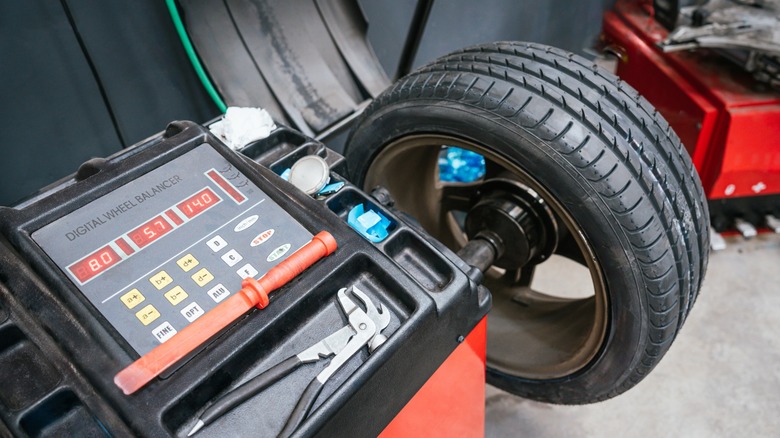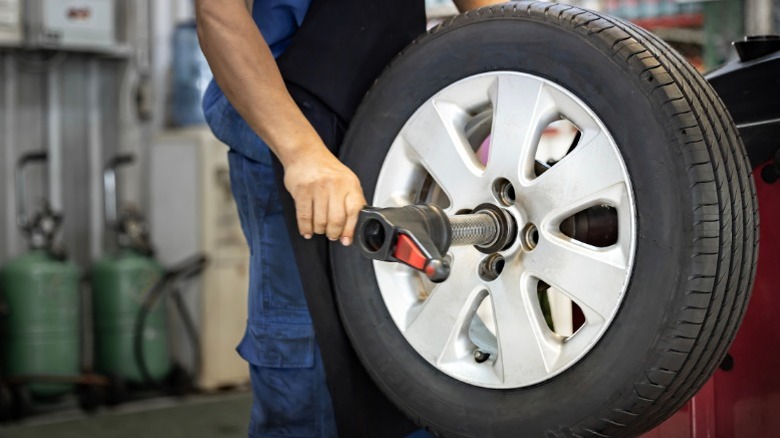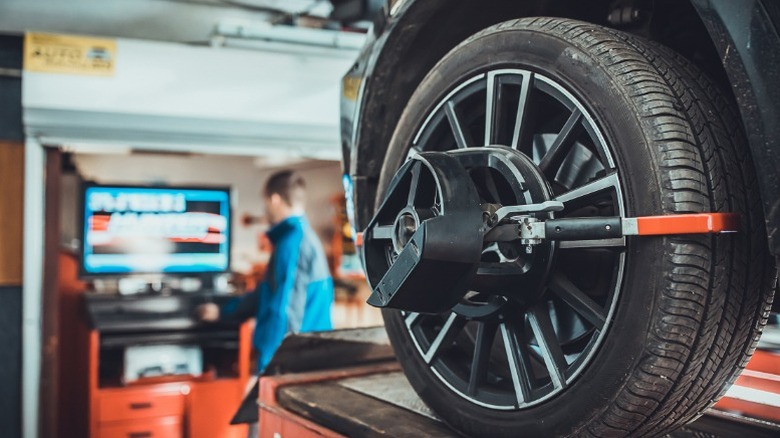Tire Balance Vs. Alignment: How To Know Which One You Need
When it comes to auto maintenance, there's a lot that goes into keeping your car in solid condition for the long haul. With regular and frequent service items — like engine oil replacements, tire pressure checks, and air filter replacements — to keep track of, it can be easy to forget about other types of maintenance. Two forms of auto care that often fall by the wayside for busy drivers include tire balancing and wheel alignment services. While these two forms of maintenance have similar names, in reality, they're two distinct procedures that are equally important for your vehicle's tires, as well as its suspension and steering systems.
A tire or wheel balancing service typically involves removing the wheels and tires from the vehicle, stripping any weights off the wheel, and mounting both the wheel and tire on a special machine. The machine then spins the tire to check for abnormalities, vibrations, and irregular tire wear. A technician interprets the data generated by the machine and uses wheel weights to balance the tire so that it spins as evenly and smoothly as possible. This service is essential to keep your tires in good condition and can contribute to both a longer tire lifespan and increased fuel mileage.
A modern wheel alignment service, on the other hand, involves parking the car on a special type of rack or lift and attaching sensors to each of the four wheels. A computer system then collects data about the wheels' angles and provides a readout to the alignment technician. The mechanic or technician will then use that data to adjust the angle of the wheels if necessary. Correct wheel angle is essential to prevent uneven tire wear, keep your steering wheel straight, and help protect the suspension system.
What are the signs that you need a tire balance?
Tires in need of a balancing service frequently cause vibrations and a shaky steering wheel. Bad brakes can also cause a shaky steering wheel, but usually while you're pressing on the brake. In contrast, if your tires need a balancing service, you'll likely notice vibrations in your steering wheel and, potentially, in the vehicle itself while driving without pressing on the brake pedal. These vibrations may not always be extremely noticeable.
However, you can check by taking your hands off the steering wheel while driving slowly on a straight road with no traffic. You should only perform this test in a safe environment, and you shouldn't keep your hands off the wheel for long. If you notice that your steering wheel is shaking or vibrating, it could be a solid sign that your tires need a balancing service. It's also worth noting that a few other issues, including poor wheel alignment, can cause vibrations and a shaky steering wheel, so visiting a professional mechanic is still a wise idea to rule out other problems.
Besides vibrations and a shaky steering wheel, wheels in need of a balancing service can also cause your car to pull to one direction and your tire tread to wear unevenly. Both of these symptoms can also be signs that you need an alignment, though, and you may need professional assistance to determine which form of maintenance you need. Finally, if it's been a long time since your last tire balancing service, it's probably a good idea to schedule one, especially if you notice any of the above symptoms. It's a service you need roughly every 5,000 to 7,500 miles or every six months, and it's one of the most effective ways to make your tires last longer.
What are the signs that you need a wheel alignment?
As mentioned, the symptoms of a vehicle in need of a wheel alignment and a tire balancing service can often be very similar and can include things like vibrations or shakiness in the steering wheel. Although, this is usually more likely to be a sign of bad tire balance or another suspension problem, as well as the vehicle pulling in one direction and uneven tire wear. However, there are a few additional issues that can point more toward poor wheel alignment than unbalanced tires.
Certain types of uneven tire wear, like heavy inner or outer wear, are commonly caused by poor wheel alignment, especially if this wear happens extremely quickly. Other symptoms that frequently indicate poor wheel alignment include squealing or squeaking tires and a crooked steering wheel. Squeaky tires can often indicate alignment issues, because misaligned wheels can lead to the tires scraping across the ground. It can also point to problems with the wheel's castor angle, or how far forward or backward the wheel tilts in the wheel well. This problem can lead to the tires rubbing against fenders and mud flaps, leading to squeaking or squealing sounds. A crooked steering wheel is also a common sign of poor wheel alignment and often indicates problems with the tie rods or other damage to the suspension and steering systems.
Remember that many of these issues can be caused by both poor wheel alignment and out-of-balance tires, as well as a handful of other suspension and steering problems. If you suspect that your car needs an alignment or a tire balancing service, the best move is to visit a professional mechanic. Many shops will even give you an alignment check for free if you're already there for another service, like a tire balance.


